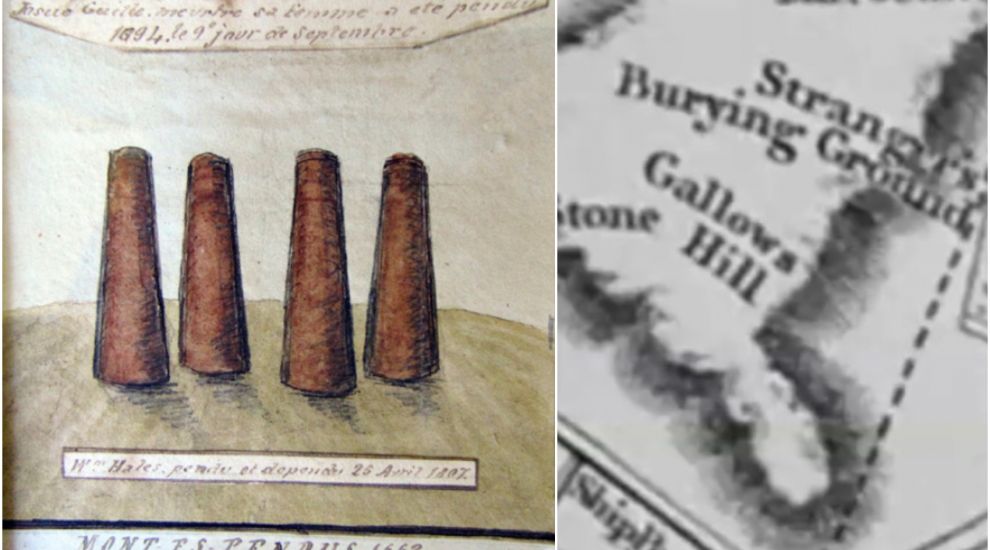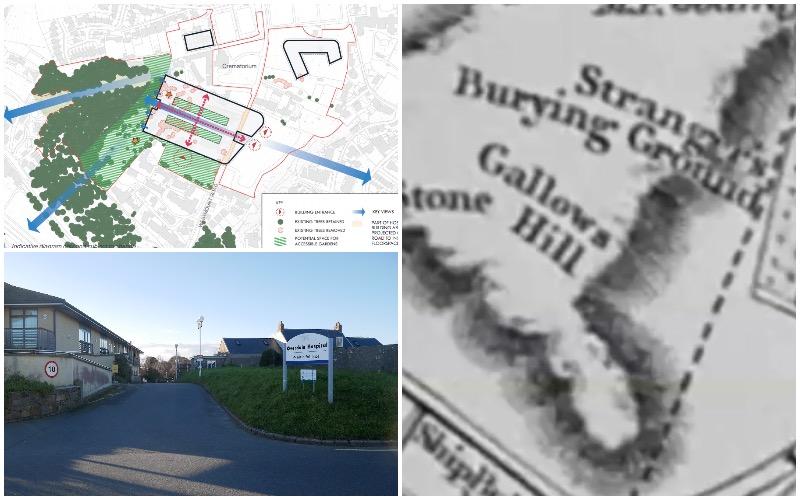


The new hospital and its accompanying highway will not be built on a site where criminals were once executed, new research has revealed.
With a new access road likely to involve flattening a rocky outcrop known as Hangman’s Corner, campaigners including the Société Jersiaise had expressed concerns about the impact of the development on the island's heritage.
But a heritage consultant working on the Our Hospital project has now concluded that the actual gallows - four pillars with a beam across from which islanders would have been hanged - were further away and outside the perimeter of the proposed site.
By overlaying the hospital site boundary over old maps of Jersey, including the Richmond projection of 1795, planner Steven Bee, who is advising the project team on heritage impacts, thinks that the gallows were where Westmount Court now stands.
The original four wooden posts, which were replaced by granite columns in 1632, stood on the summit of Mont és Pendus, which became Mont Patibulaire, named after the horizontal bar of a cross or set of gallows.

Pictured: The 1795 Richmond map of Jersey, with the new hospital boundary laid over the top in the bottom right-hand corner.
The last recorded execution on the site was in 1829, after which the gallows moved to the prison.
“The increasing sophistication of mapping during the 18th and 19th century gives us a clearer indication of the likely position of the gallows,” said Mr Bee. “By 1795, when Richmond produced his map, he could locate the gallows pretty specifically.
“Our archeological consultants have now done a map regression, which positions the four columns just outside the boundary of the Overdale site.
“And as Westmount Road wasn’t built until 1865, it is unlikely that it was anywhere along the line of the road.”
Mr Bee added that Godfray’s map of 1849 identified Gallows Hill but did not reference the actual columns, suggesting that they had moved by then.

Pictured: Steven Bee, who is advising the Overdale project team on heritage impacts, thinks that the gallows were where Westmount Court now stands.
Turning to more ancient times, Mr Bee said that Field 1550 - a site the east of the Crematorium, which Express previously revealed had already been identified as a potential prehistoric burial site - would be explored further, as would the main site to the west of Westmount Road, which had been identified as having “moderate’ archeological potential”.
This could be by a desk-top assessment or a walking survey, right through to excavation, if deemed appropriate.
Mr Bee, who has previously worked for English Heritage, recently spoke to the two groups - the Community Liaison Group and the Neighbourhood Forum - set up to improve engagement with the project team.
He also explained the historical significance of buildings constructed in the 19th century, including the Grade 2-listed Mont à l’Abbé cemetery, the Grade 3-listed Thorpe Cottage and the Grade 4-list Briez Izel property opposite.

Pictured: Rocks found in Field 1550 in 2018 by Société Jersiaise researcher Nick Aubin, which are possibly from a Neolithic burial site.
In the 20th century, the Germans built a heavy machine-gun nest on the site of a former belvedere within the crux of the Westmount Road hairpin, which was demolished in the 1980s.
There was also a German gun battery - Batterie Endrass - which stood on the site of Westmount Court, just south of a JFA-owned football pitch, which is where the current hospital now stands.
In conclusion, Mr Bee said it was important that the project considered, from a heritage perspective:
“There is an important obligation to mitigate the heritage impacts and use the opportunity to better interpret the history of this part of the Island,” he said. “And I want to assure people that the impact of the hospital on the Island’s heritage has been considered from the outset.”
In response, Société Jersiaise Vice-President Stuart Fell said he was reassured that there had been the right level of input from the early days, which had not been reflected in early explanations from the Government on what they were doing.
“If they had been explained earlier, then we wouldn’t be in a position of potential criticism.”
In February, the Société had urged politicians to reject proposals for a future hospital highway through Westmount in a rare political intervention.
Historians enter the battle of Westmount
Field marked for hospital could be 'lost' Neolithic monument site
FOCUS: What's the evidence for a Neolithic monument under a future hospital field?
Pictured top: 19th century image of the four granite stones that supported the gallows (Jersey Heritage via Société), and an extract of a historic map indicating Gallows Hill.
Comments
Comments on this story express the views of the commentator only, not Bailiwick Publishing. We are unable to guarantee the accuracy of any of those comments.